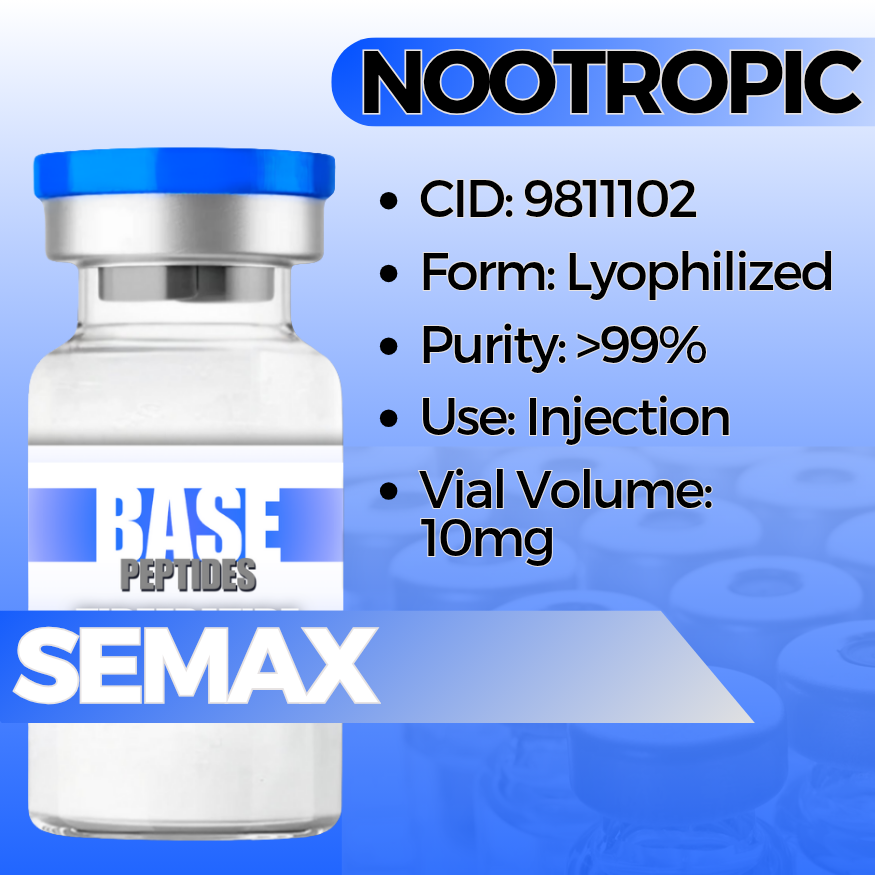Semax
Semax
Base Peptides are intended for licensed medical professionals and experienced researchers. Reconstitution required. Dosing and use instructions are not provided.
Couldn't load pickup availability
Semax — ACTH(4-10)-PGP Heptapeptide (MEHFPGP)
Semax is a synthetic heptapeptide derived from the ACTH(4-10) fragment with a Pro-Gly-Pro (PGP) tail. It’s used in research to explore stress adaptation, neuroplasticity, cognition, and neuroimmune balance while avoiding sedative mechanisms.
- CAS: 80714-61-0
- PubChem CID: 9811102
- Formula / MW: C37H51N9O10S · ~813.9 Da
- Sequence: Met-Glu-His-Phe-Pro-Gly-Pro (MEHFPGP)
- Origin: Analogue of ACTH(4-10) with a C-terminal PGP extension
- Semax modulates GABAergic and monoaminergic pathways tied to stress, focus, and mood.
- It has been studied for effects on BDNF/TrkB signaling—key players in learning and synaptic plasticity.
- It also shows neuroimmune effects (cytokine balance), linking inflammation with brain function in models of stress.
- To probe stress resilience without sedative confounds.
- To study memory, attention, and neuroplasticity markers (e.g., BDNF expression).
- To examine neuroimmune cross-talk via cytokine profiling and gene-expression panels.
Key Studies — What Was Tested, What Changed, Why It Matters
Cognition & plasticity (BDNF-linked effects)
- What was tested: Semax exposure in rodent learning/memory tasks with hippocampal assays.
- What changed: Improved task performance with increases in BDNF/TrkB expression and antioxidant markers in cortex/hippocampus.
- Why it matters: Supports Semax as a model for neuroplasticity—useful when studying adaptive learning and synaptic signaling.
Stress & anxiety-response paradigms
- What was tested: Behavioral stress models (e.g., restraint/novelty) with neurotransmitter and cytokine readouts.
- What changed: Reduced anxiety-like behavior, more balanced GABA/glutamate signaling, and shifts toward anti-inflammatory cytokine profiles.
- Why it matters: Shows Semax can help parse neuroimmune mechanisms of stress adaptation without confounding sedation.
Ischemia/oxidative stress models
- What was tested: Global/forebrain ischemia models and oxidative-stress assays.
- What changed: Signals consistent with neuroprotection (e.g., lipid-peroxidation reduction, NO modulation) and better behavioral recovery.
- Why it matters: Provides a basis for studying injury-response cascades and antioxidant gene programs.
Potential Research Applications
Neuroscience & Behavior
- BDNF/TrkB and synaptic-plasticity assays
- Attention, memory, and stress-behavior tasks
Neuroimmune Cross-Talk
- Cytokine panels (Th1/Th2 balance)
- Glia markers and neuroinflammation
Comparative Peptide Models
- Selank / Semax side-by-side
- Combination with trophic or antioxidant pathways
Synergistic Peptides (for Study Design)
Selank
- Why pair: Neuroimmune-modulating heptapeptide; complements Semax on stress and focus pathways.
- Angle: Dual-arm designs for behavior + cytokine/BDNF readouts.
GHK-Cu
- Why pair: ECM and trophic signaling; useful in repair and antioxidant panels alongside Semax.
- Angle: Gene-expression arrays for neurotrophic + matrix pathways.
MOTS-c
- Why pair: AMPK-centric metabolic stress signaling may complement Semax’s CNS focus.
- Angle: Fatigue-resilience, oxidative-stress, and behavior endpoints.
Design Notes
- Standardize timing (short-acting peptide)—pair behavior with molecular sampling.
- Include both central and peripheral markers (brain + serum cytokines).
- Protect from oxidation/light; prepare fresh aliquots for reproducibility.
Known Concerns (Context)
- Stability: Solution-sensitive; handle cold and minimize light exposure.
- Model dependence: Behavioral outcomes vary with environment—tighten protocols (habituation, time-of-day, handling).
- General: Research use only; not for human consumption or therapeutic use.
Follow institutional SOPs for neurobehavioral studies and peptide handling.
Specifications & Handling
- Form: Lyophilized powder (lot-coded)
- Purity: ≥ 99% (HPLC/MS; lot-verified)
- Storage: ≤ −20 °C; protect from light/moisture
- In solution: Aliquot promptly; avoid repeat freeze–thaw
- Additives: None unless specified per lot
- Packaging: Tamper-evident; research-only labeling
Regulatory & Use Notice
Sold for laboratory research use only. Not for human consumption, medical, or veterinary use. No human-use instructions are provided. Buyer is responsible for safe handling and regulatory compliance.
Semax Peptide Research | ACTH(4-10)-PGP Heptapeptide | BDNF/TrkB, Stress & Neuroimmune Studies


